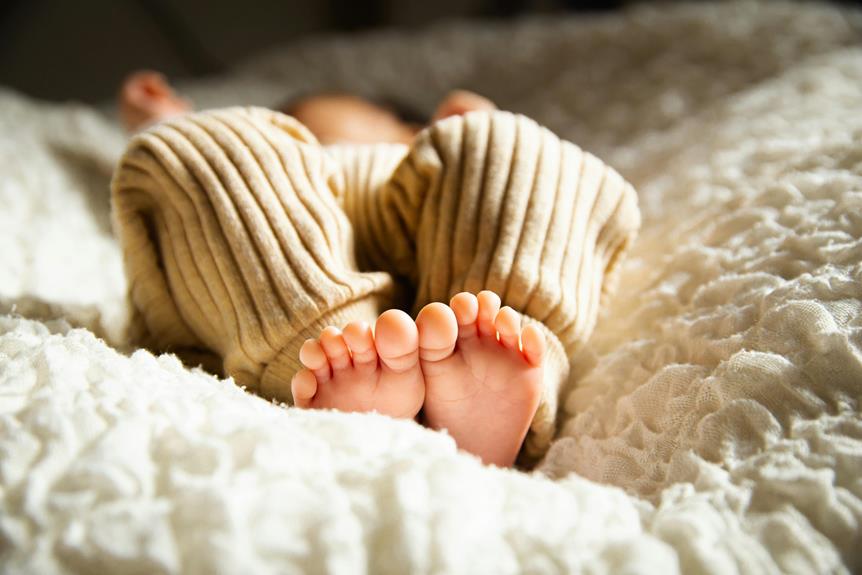To reduce the risk of SIDS, make sure to always place your baby on their back for sleep, use a firm mattress, and keep the crib free from loose bedding or soft objects. Remember to room-share without bed-sharing for the first six months and avoid exposing your baby to smoke, alcohol, or drugs. Following these safe sleep practices is essential in promoting a safe sleeping environment for your little one.
Importance of Safe Sleep Practices
To reduce the risk of SIDS, understanding the importance of safe sleep practices is crucial. By following these guidelines, you can create a safe sleep environment for your baby.
Firstly, always place your baby on their back for naps and nighttime sleep. This position helps reduce the risk of SIDS. Additionally, it's important to ensure that your baby sleeps on a firm mattress, free from any loose bedding or soft objects that could pose a suffocation hazard. Keep the crib bare and avoid using pillows, bumper pads, or stuffed animals.
Room-sharing without bed-sharing is recommended for the first six months as it promotes safe sleep practices and allows for easier feeding and comforting during the night. Finally, avoid exposing your baby to smoke, alcohol, or illicit drugs, as these can increase the risk of SIDS.
Creating a Safe Sleep Environment
Ensuring a safe sleep environment for your baby is essential in reducing the risk of SIDS. To create a safe sleeping space, start with a firm and flat mattress in a safety-approved crib, bassinet, or play yard. Make sure the fitted sheet is snug and free of any loose bedding, pillows, or toys. Keep the sleep area clutter-free to prevent suffocation hazards.
Position the crib away from windows, blinds, cords, and heaters to avoid potential entanglement or overheating. Maintain a comfortable room temperature (around 68-72°F or 20-22°C) to prevent your baby from getting too hot. Dress your baby in light sleep clothing to avoid the need for extra blankets.
Consider using a pacifier at naptime and bedtime, as it has been linked to a reduced risk of SIDS. Remember to place your baby on their back for all sleep times and encourage tummy time during awake periods. By following these guidelines, you can provide a safe sleep environment that promotes your baby's well-being.
Positioning Your Baby for Sleep
For optimal safety and comfort during sleep, position your baby correctly in their crib or bassinet. Place your baby on their back for all sleep times, including naps. This position is crucial to reduce the risk of Sudden Infant Death Syndrome (SIDS).
Avoid placing your baby on their side or stomach to sleep, even if they seem more settled in those positions. Ensure that your baby's face is clear of any obstructions, such as blankets, toys, or pillows. Dress your baby in sleep clothing like a one-piece sleeper to keep them warm instead of using loose blankets.
Make sure the crib or bassinet mattress is firm and fits snugly to prevent any gaps where your baby could get trapped. Keep the sleep area free from any potential hazards. By following these positioning guidelines, you can create a safe sleep environment that promotes your baby's well-being.
Using Safe Sleep Products
When choosing safe sleep products for your baby, prioritize simplicity and functionality to reduce the risk of Sudden Infant Death Syndrome (SIDS). Opt for a firm and flat mattress that fits snugly in the crib without any gaps. Avoid using soft bedding, such as pillows, comforters, or bumper pads, as these can pose suffocation hazards. Instead, dress your baby in a sleep sack or a wearable blanket to keep them warm without the need for loose bedding.
Additionally, choose a crib that meets current safety standards, with slats that are no more than 2-3/8 inches apart to prevent your baby from getting stuck or falling out. Skip the crib accessories like mobiles, toys, or wedges, as these can also increase the risk of SIDS. If using a pacifier, make sure it's clean and safe for your baby's age.
Monitoring Your Babys Sleep Environment
To keep your baby safe during sleep, regularly monitor their sleep environment for any potential hazards or changes. Check that the crib mattress fits snugly without gaps where your baby could get trapped. Ensure there are no loose bedding, toys, or pillows in the crib that could pose a suffocation risk.
Keep the room temperature comfortably cool, between 68-72°F (20-22°C), to prevent overheating. Confirm that the crib is placed away from windows, blinds, cords, or any other strangulation hazards. Verify that the smoke and carbon monoxide detectors in the room are functioning correctly.
Position your baby on their back for every sleep time until they're at least one year old. If using a pacifier, offer it when placing your baby down for sleep but don't force it if they refuse.

